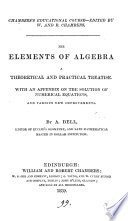 | Bourdon (M., Louis Pierre Marie) - Algebra - 1831 - 446 pages
...negative roots greater than the number of PERMANENCES. 331 . Consequence. When the roots of an equation are all real, the number of positive roots is equal...negative roots is equal to the number of permanences. For, let in denote the degree of the equation, n the number of variations • of the signs, p the number... | |
 | Charles Davies - Algebra - 1835 - 378 pages
...Consequence. When the roots of an equation are all real, the number of positive roots is equal to Hie number of variations, and the number of negative roots is equal to the number of permanences. For, let TO denote the degree of the equation, n the number of variations of the signs, p the number... | |
 | John Radford Young - 1835 - 302 pages
...necessarily, p=p' and r = t^ ; consequently, when the roots are all real, the number of positive roots will be equal to the number of variations, and the number of negative roots equal to the number of permanencies.' CHAPTER. II. ON THE TRANSFORMATION OF EQUATIONS. (19.) Algebraical... | |
 | Algebra - 1838 - 372 pages
...negative roots greater than the number of PERMANENCES. 325. Consequence. When the roots of an equation are all real, the number of positive roots is equal...negative roots is equal to the number of permanences. For, let m denote the degree of the equation, n the number of variations of the signs, p the number... | |
 | Andrew Bell (writer on mathematics.) - 1839 - 500 pages
...lie discovered the important theorem, called " the rule of signs," that in an equation whose roots are all real, the number of positive roots is equal to the number of variations of the signs of its terms tяken in succession, and the number of the negative roots to that of the... | |
 | Charles Davies - Algebra - 1842 - 368 pages
...negative roots greater than the number of PERMANENCES. 325. Consequence. When the roots of an equation are all real, the number of positive roots is equal...negative roots is equal to the number of permanences. For, let m denote the degree of the equation, n the number of variations of the signs, p the number... | |
 | John Radford Young - Equations - 1842 - 276 pages
...and » = »' Consequently, when the roots are all real, the number of positive roots will be exactly equal to the number of variations, and the number of negative roots to the number of permanencies. It must be borne in mind, however, that whether the roots are all real... | |
 | Charles Davies - Algebra - 1845 - 382 pages
...negative roots greater than the number of PERMANENCES. Consequence. 328. When the roots of an equation are all real, the number of positive roots is equal...number of variations, and the number of negative roots to , the number of permanences. For, let m denote the degree of the equation, n the number of variations... | |
 | Algebra - 1847 - 408 pages
...negative roots greater than the number of PERMANENCES. Consequence. 328. When the roots of an equation are all real, the number of positive roots is equal...the number of variations, and the number of negative Toots to the number of permanences. For, let m denote the degree of the equation, n the number of variations... | |
 | Stephen Chase - Algebra - 1849 - 348 pages
...362). Therefore, Cor. i. If the roots of an equation be all real, the number of positive roots must be equal to the number of variations ; and the number of negative roots, to the number of permanences. See § 218. 1, 2, 3. § 362. J.) If any term of the equation be wanting,... | |
| |